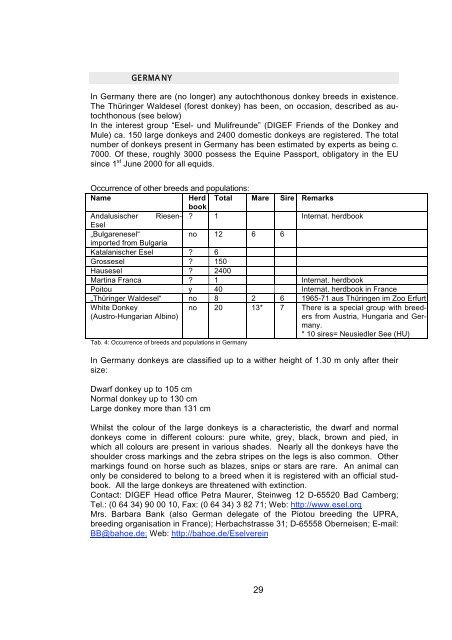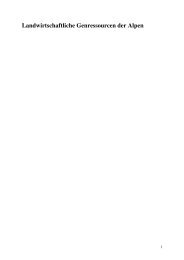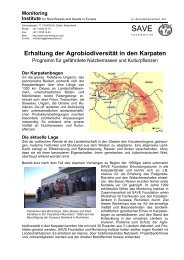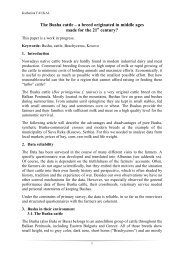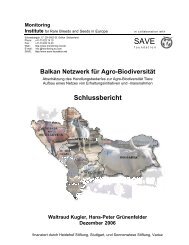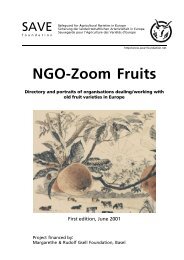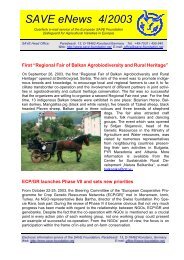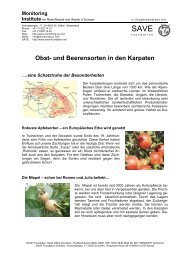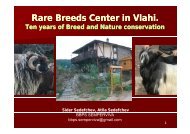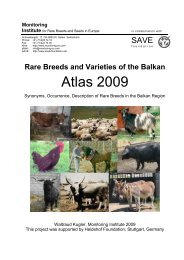Donkey Breeds in Europe - Safeguard for Agricultural Varieties in ...
Donkey Breeds in Europe - Safeguard for Agricultural Varieties in ...
Donkey Breeds in Europe - Safeguard for Agricultural Varieties in ...
You also want an ePaper? Increase the reach of your titles
YUMPU automatically turns print PDFs into web optimized ePapers that Google loves.
GERMANY<br />
In Germany there are (no longer) any autochthonous donkey breeds <strong>in</strong> existence.<br />
The Thür<strong>in</strong>ger Waldesel (<strong>for</strong>est donkey) has been, on occasion, described as autochthonous<br />
(see below)<br />
In the <strong>in</strong>terest group “Esel- und Mulifreunde” (DIGEF Friends of the <strong>Donkey</strong> and<br />
Mule) ca. 150 large donkeys and 2400 domestic donkeys are registered. The total<br />
number of donkeys present <strong>in</strong> Germany has been estimated by experts as be<strong>in</strong>g c.<br />
7000. Of these, roughly 3000 possess the Equ<strong>in</strong>e Passport, obligatory <strong>in</strong> the EU<br />
s<strong>in</strong>ce 1 st June 2000 <strong>for</strong> all equids.<br />
Occurrence of other breeds and populations:<br />
Name Herd<br />
book<br />
Total Mare Sire Remarks<br />
Andalusischer<br />
Esel<br />
Riesen- ? 1 Internat. herdbook<br />
„Bulgarenesel“<br />
no 12 6 6<br />
imported from Bulgaria<br />
Katalanischer Esel ? 6<br />
Grossesel ? 150<br />
Hausesel ? 2400<br />
Mart<strong>in</strong>a Franca ? 1 Internat. herdbook<br />
Poitou y 40 Internat. herdbook <strong>in</strong> France<br />
„Thür<strong>in</strong>ger Waldesel“ no 8 2 6 1965-71 aus Thür<strong>in</strong>gen im Zoo Erfurt<br />
White <strong>Donkey</strong><br />
no 20 13* 7 There is a special group with breed-<br />
(Austro-Hungarian Alb<strong>in</strong>o)<br />
ers from Austria, Hungaria and Germany.<br />
* 10 sires= Neusiedler See (HU)<br />
Tab. 4: Occurrence of breeds and populations <strong>in</strong> Germany<br />
In Germany donkeys are classified up to a wither height of 1.30 m only after their<br />
size:<br />
Dwarf donkey up to 105 cm<br />
Normal donkey up to 130 cm<br />
Large donkey more than 131 cm<br />
Whilst the colour of the large donkeys is a characteristic, the dwarf and normal<br />
donkeys come <strong>in</strong> different colours: pure white, grey, black, brown and pied, <strong>in</strong><br />
which all colours are present <strong>in</strong> various shades. Nearly all the donkeys have the<br />
shoulder cross mark<strong>in</strong>gs and the zebra stripes on the legs is also common. Other<br />
mark<strong>in</strong>gs found on horse such as blazes, snips or stars are rare. An animal can<br />
only be considered to belong to a breed when it is registered with an official studbook.<br />
All the large donkeys are threatened with ext<strong>in</strong>ction.<br />
Contact: DIGEF Head office Petra Maurer, Ste<strong>in</strong>weg 12 D-65520 Bad Camberg;<br />
Tel.: (0 64 34) 90 00 10, Fax: (0 64 34) 3 82 71; Web: http://www.esel.org<br />
Mrs. Barbara Bank (also German delegate of the Piotou breed<strong>in</strong>g the UPRA,<br />
breed<strong>in</strong>g organisation <strong>in</strong> France); Herbachstrasse 31; D-65558 Oberneisen; E-mail:<br />
BB@bahoe.de; Web: http://bahoe.de/Eselvere<strong>in</strong><br />
29


